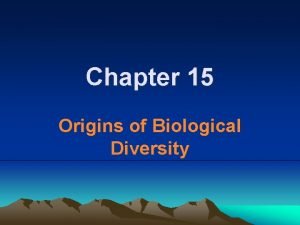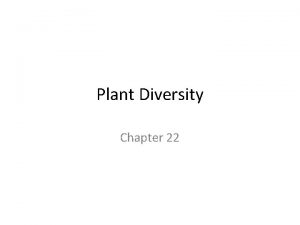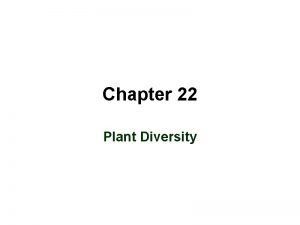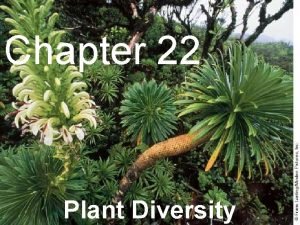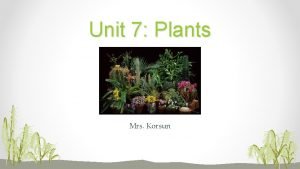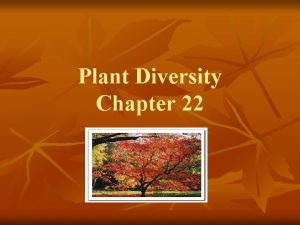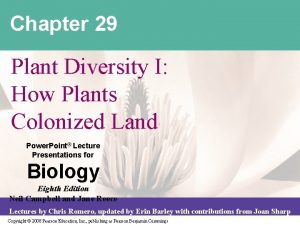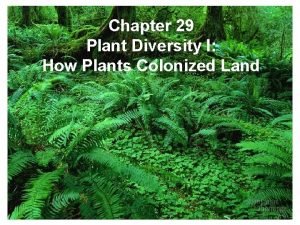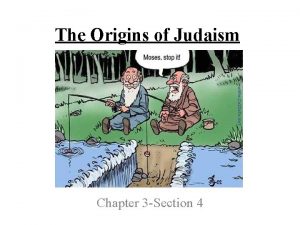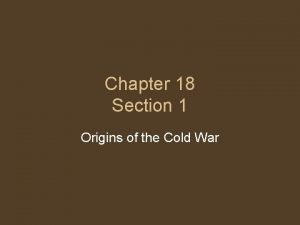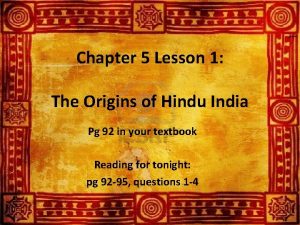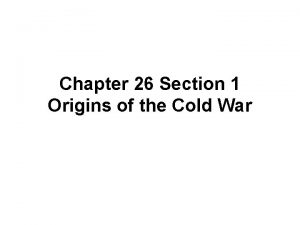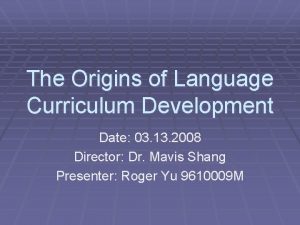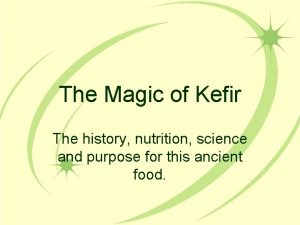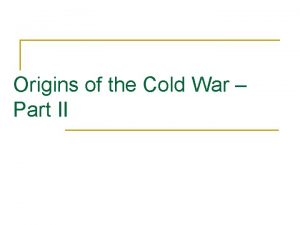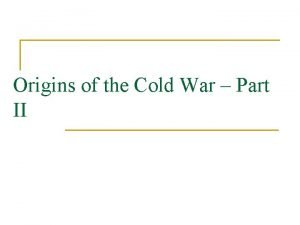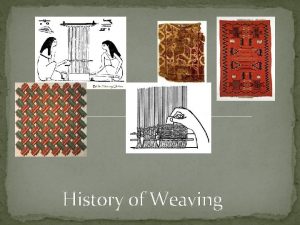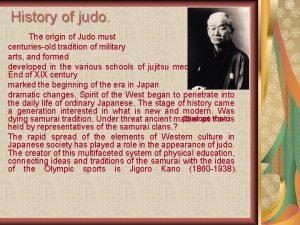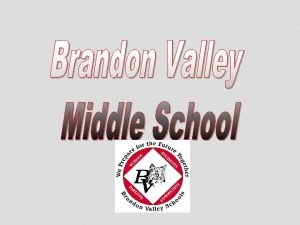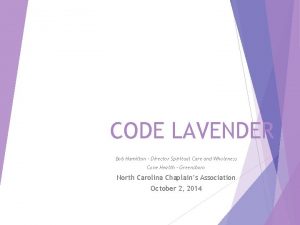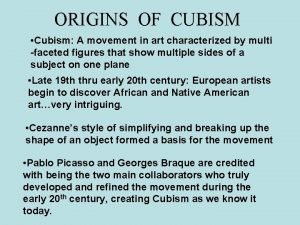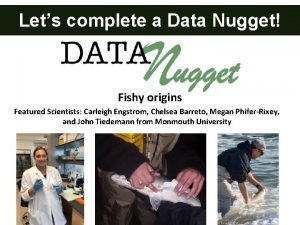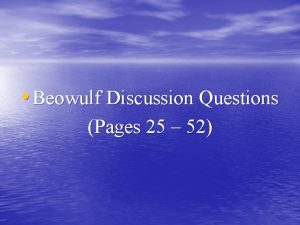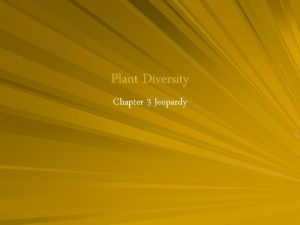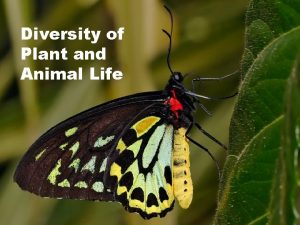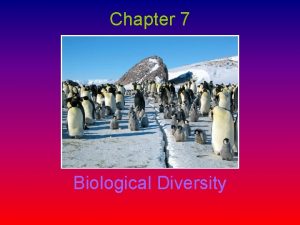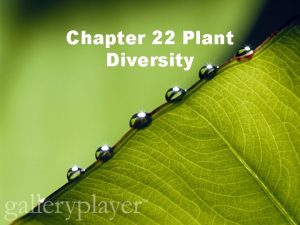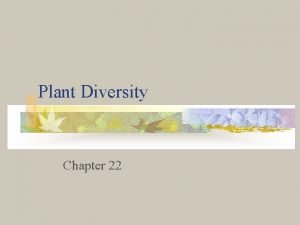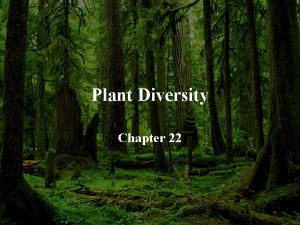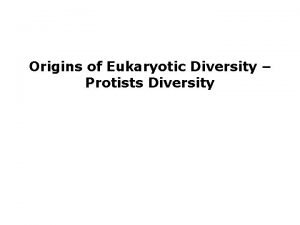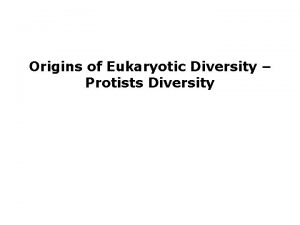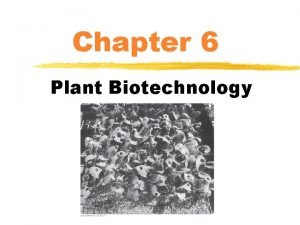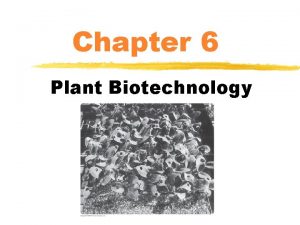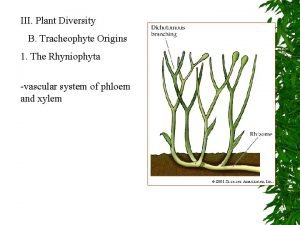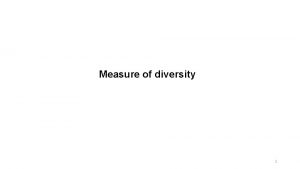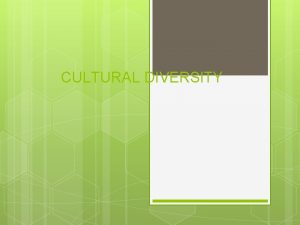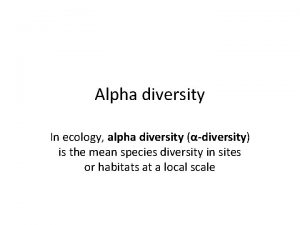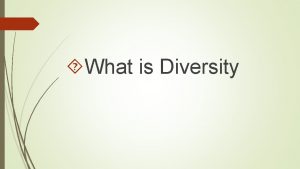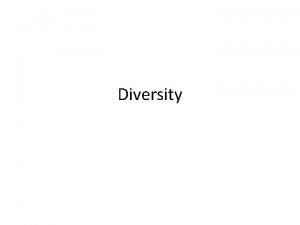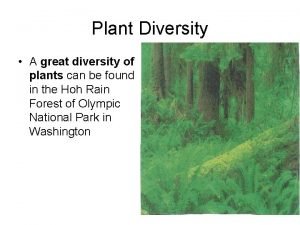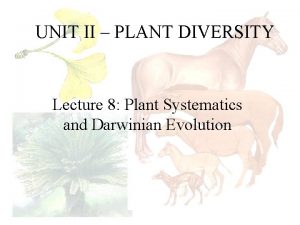Chapter 20 Plant Diversity 20 1 Origins of





















































- Slides: 53

Chapter 20: Plant Diversity

20. 1: Origins of Plant Life • Words to Know: Plant, Cuticle, Stomata, Vascular System, Lignin, Pollen Grain, Seed, algae, eukaryote, photosynthesis, chloroplast, herbivore. • Plants are multicellular eukaryotes, most of which produce their own food through photosynthesis and have adapted to life on land.

Land Plants Evolved from Green Algae • • • Green algae and plants have the same type of chlorophyll, use starch as a storage product and most algae also contain cell walls. Evidence from genetic analysis points to one ancient species of green algae that is the common ancestor to ALL plants. Charophyceae shared the following characteristics with modern day plants: – Multicellular body with specialized cells and tissues. – A method of cell division allowing cell communication. – Reproduction involving sperm and egg. • The earliest plant fossils date to more than 450 million years ago.

Plants on Land • Plants have adaptations that allow them to retain moisture, transport water, and other resources between plant parts, grow upright and reproduce without freestanding water.

Retaining Moisture • The surface of plants is covered with a Cuticle – a waxy, waterproof layer that helps hold in moisture. • The cuticle has tiny holes called Stomata that can open and close to help prevent water loss or allow movement of air through the plant.

Transporting Resources • A Vascular System is a collection of specialized tissues that bring water and mineral nutrients up from the roots and disperse sugars down from the leaves. • A vascular system allows a plant to grow higher off the ground.

Reproducing on Land • In ALL plants, eggs are fertilized within the tissue of the parent plant. • There the fertilized egg develops into an embryo. • A Pollen Grain is a two-celled structure that contains a cell that will divide to form sperm. • Pollen can be carried by wind or animals to female reproductive structures. • A Seed is a storage device for a plant embryo. – A seed in the right condition can develop into an adult plant.

20. 2: Classification of Plants • Words to Know: Pollination, Gymnosperm, Angiosperm, Cone, Flower, Fruit, seed, vascular system, pollen.

1. Seedless Nonvascular Plants • Plants that do NOT produce seeds or have no vascular system are called seedless nonvascular plants. • They grow close to the ground or on surfaces like tree trunks. • They also rely on freestanding water for reproduction. • There are the Mosses.

2. Seedless Vascular Plants • About 300 million years ago, during the Carboniferous period, shallow swamps were home to enormous seedless vascular plants. • The fossils of these early plants are what became fossil fuels that we used today. • Examples of these are Ferns

Ferns • Ferns are the most successful survivors of the Carboniferous period, with over 12, 000 current species. – Grow from underground stems called Rhizomes. – Large leaves are called Fronds. – Newly forming fronds, called fiddleheads, uncurl as they grow.

3. Seed Plants • Seed plants can reproduce without free standing water. – Seed plants produce pollen that can be carried by wind, water, air and animals. – Pollination occurs when pollen meets female reproductive parts of the same plant species. • Seeds nourish and protect plant embryos. – A seed consists of a protective coat that contains the food supply. • Seeds allow plants to disperse to new places. – Wind, water, or animals often carry seeds far from the parent plant. – Scientists hypothesize that seed plants evolved as the Earth’s climate changed from warm and moist to hot and dry. • Seed plants can be grouped according to their seeds: – 1. A Gymnosperm is a seed plant whose seeds are NOT enclosed in fruit. • Most gymnosperms are cone bearing. • A Cone is the reproductive structure of most gymnosperms. – 2. An Angiosperm is a seed plant whose seeds ARE enclosed in some type of fruit.

3 A. Gymnosperms: Conifers • These are familiar trees with needlelike leaves. • Ex: Pines, redwoods, spruce, cedar, fir, giant sequoia, and juniper. • Supply most of the timber for paper, cardboard, housing lumber and plywood. • Many are evergreen – grow year round. • Tend to grow old and grow tall.

3 B. Angiosperms • Belong to their own phylum – Phylum Anthophyta • Commonly called flowering plants. • A Flower is the reproductive structure of flowering plants. – Flowers protect gametes and fertilized eggs. • A Fruit is the mature ovary of a flower. – Fruit can be a juicy peach, the sings attached to a maple seed, or the fluff surrounding dandelion seeds.

20. 3: Diversity of Flowering Plants • Words to Know: Cotyledon, Monocot, Dicot, Wood, fruit, flower, pollination, pollen, lignin. • Flowering Plants have Unique Adaptations

Fruits and Seed Dispersal • A fruit is a flower’s ripened ovary, which surrounds and protects the seed or seeds. • Fruit plays a huge role is seed dispersal. • Seeds pass through the animal, and are deposited along with a convenient supply of fecal fertilizer that is helpful during germination. • Others take the form of burrs that cling to passing wildlife, or fibers that help spread seeds by wind.

Flowers are Classified into Two Groups • Botanists classify flowering plants into two groups based on two basic kinds of seed: seeds with one or two cotyledons. • A Cotyledon is an embryonic leaf inside a seed.

Monocots • Flowering plants whose embryos have one seed leaf are Monocots. • Typically have parallel veins in long, narrow leaves. • Flowers occur in multiples of 3. • Vascular bundles are scattered throughout the stem.

Dicots • Dicots are flowering plants whose embryos have Two seed leaves. • Have leaves with netlike veins. • Flower parts occur in multiples of four or five. • Vascular tissues are arranged in rings. • .

Chapter 21: Plant Structure and Function Botany is the study of plants.

21. 1: Tissues • Words to Know: Vascular Tissue, Xylem, Phloem, vascular, system, cuticle

Plant Organs have 3 Tissue • Vascular Tissue Systems • Vascular Tissue transports water, mineral nutrients, and organic compounds to all parts of the plant. • Plants can transport necessary fluids and nutrients throughout their systems. • Xylem is the vascular tissue that carries water and dissolved mineral nutrients up from the roots to the rest of the plant. • Phloem is the vascular tissue that carries the products of photosynthesis through the plant.

Xylem and Phloem • Xylem : Water and dissolved minerals move up from the roots to the rest of the plant through xylem. • The loss of water vapor from plants is called Transpiration. • As leaves transpire, the outward flow of water lowers the pressure in the leaf xylem, creating a vacuum that pulls water upward. • Phloem carries plant nutrients, including minerals and sugars, throughout the plant. • Phloem tissue is living tissue.

21. 3: Roots and Stems • Words to Know: Vascular Cylinder, Root Hair, Root Cap, Fibrous Root, Taproot,

Roots • Roots may make up over half of the body of a plant. • Roots anchor the plant to the ground, and from the soil they absorb water and minerals the plant need.

Types of Roots • Roots take one of two basic forms: Fibrous Roots, and Taproots. • Fibrous Root systems make fine branches in which most of the roots are the same size. – These roots spread like a mat beneath the soil surface, and firmly anchor the plant to the ground. • Taproot systems have a long, thick, vertical root with smaller branches. – Long taproots allow plants to get water from deep in the ground. – Thick taproots can store food. • Ex: Radishes, carrots, and beets.

Stems • Stems help hold plants up towards the sun. • Stems house a majority of the vascular system and can store food and water. • Most stems grow above ground, but potatoes and ginger are examples of stems that grow underground.

21. 4: Leaves Stomata and Guard Cells • The top part of a leaf has most of the chloroplasts and is where most photosynthesis takes place. • The underside portion of a leaf has stomata and is the site of transpiration. • A pair of Guard Cells surround each stoma, and can open and close by changing shape. • During the day, most guard cells stay open to allow CO 2 for photosynthesis to enter. • If a plant is losing water, the guard cells will close up to prevent water loss.

Systems for Photosynthesis • The leaves of the plant are the main site for photosynthesis. • The broad, flat shape of many leaves allows for light gathering on the upper surface and gas exchange on the underside.

• Leaves are adapted for photosynthesis in the plant’s particular environment. • Ex: Cactus leaves are designed to protect from predators and store water. • Ex: Pine needles have small needles with small surface area and a thick waxy epidermis that protects them from cold damage. • Aquatic plane have flexible petioles and the stomata are on the top side of the plant. • Tropical plants have very large, broad leaves to absorb sunlight. • Some plants are predators, like pitcher plants and venus flytraps. Leaf Adaptations

Chapter 22: Plant Growth, Reproduction, and Response

Chapter 22: Plant Growth, Reproduction, and Responses • 22. 1: Plant Life Cycle • Words to Know: Alternation of Generations, Sporophyte, Gametophyte, pollination, meiosis, diploid, haploid, zygote, mitosis, sporangia, flagella.

Plant Life Cycles Alternate • Plants produce gametes, but their life cycle includes a few extra steps. • Plants complete their life cycle by alternating between two phases. • One phase involves a Diploid (2 n) plant body that produces spores. • The other phase involves a Haploid (n) plant body that produces gametes. • This type of life cycle that alternates between diploid and haploid phases is called Alternation of Generation.

General Overview of Alternation of Generation • • The diploid phase begins with a fertilized egg (zygote). This divides by mitosis and grows into a mature Sporophyte. A mature sporophyte has cells that divide by meiosis to produce haploid spores. A Spore marks the beginning of the Haploid phase of the plant life cycle. A spore divides by mitosis and grows into a mature Gametophyte (gamete producing plant). Specialized parts of a mature gametophyte produce gametes (sperm and egg). When sperm meets egg, fertilization takes place and the cycle continues with a new sporophyte.

Moss Life Cycle • The gametophyte stage is dominant. • The sperm can get to the egg when water is present.

Fern Life Cycle • The sporophyte is the dominant stage. • The plants that you recognize as ferns. • On the underside of a fern leaf (frond) you will see clusters of sporangia called sori. • Spores are released from the sori when they are mature. • When water is present, male structures release sperm that swim towards the egg. • After fertilization, Fiddleheads form and slowly uncurl as they grow. • Eventually the sporophyte will grow into a new fern.

Conifer Life Cycle • The sporophyte is the dominant stage. • Seed plants produce two types of spores that develop into male and female gametophytes. • Confers like Pine trees produce 2 different cones (male and female). • Female cones are usually larger and more scaly than male cones. • Male spores develop into pollen and female spores develop into eggs. • Pollination occurs in a cone-bearing plant when a pollen grain reaches the small opening of an ovule. • A pollen tube will then form down to the egg. • If sperm fertilizes egg a zygote forms and grows into a new plant.

Conifer Life Cycle

22. 2: Reproduction in Flowering Plants • Words to Know: Sepal, Petal, Stamen, Carpel, Ovary, Endosperm, Double Fertilization, cotyledon, fruit.

Flowers • Flower parts are arranged in layers. • Sepals are modified leaves that protect the developing flowers. • Petals are also modified leaves that are usually bright colors to attract animal pollinators. – Flowering plants that are not pollinated by animals usually have very small sepals and petals, or none at all.

Flowers • Most flowers have both male and female structures. • A Stamen is the male structure of a flower. – It is made up of the filament (stalk) and the anther (produces pollen grains). • The Carpel (Pistil) is the female structure made up of three parts: – The Stigma is the sticky top that serves as the landing spot for pollen. – The Style is the tube connecting the stigma to the ovary. – The Ovary is found at the base of the flower and produces gametophytes.

Pollination • When a pollen grain reaches the stigma of the same plant species, pollination has occurred. • .

Fertilization The sporophyte is the dominant stage.

Male Gametophytes • Anthers produce pollen grains. • Cell within the anthers divide by meiosis to produce four male spores. • Each spore divides by mitosis, producing two haploid cells.

Female Gametophytes • One female gametophyte can form in each ovule of a flower’s ovary. • The end product is an embryo sac and an egg.

Seeds and Fruit • At fertilization the ovule becomes a seed (contains an embryo and a nutritious endosperm in a seed coat). • While the seed develops, the surrounding ovary grows into a fruit. • Fruit is the mature ovary of a flowering plant. – Ex: Apples, watermelons, and cherries are fruits. – Sweet peppers, tomatoes, cucumbers, peanut shells are also considered “fruits”

22. 3: Seed Dispersal and Germination • Words to Know: Dormancy, Germination

Seed Dispersal • Seed dispersal is important because a plant that grows right next to its parent may compete with it for space, sunlight, water and nutrients. • Fruits come in many shapes and sizes, each adapted to spread seed to new areas. • Fleshy fruits are designed to be eaten and digested with the seeds passing through the digestive system. • Some plants have burrs, which are designed to stick to fur. • Seeds dispersed by wind often have fruits that act like parachutes or wings.

Seeds Grow • Germination • During Germination, the embryo breaks out of the seed coat and being stop grow into a seedling. • Germination begins when the embryo starts to take up water and continues until the embryo can do photosynthesis on its own.

22. 5: Plant Hormones and Responses • Words to Know: Hormones, Gibberellin, Ethylene, Cytokinin, Auxin, Tropism, Phototropism, Thigmotropism, Gravitropism, Phototropism

Plant Hormones • A Hormone is a chemical messenger produced in one part of an organism that stimulates or suppresses the activity of cells in another part. • Hormones regulate many of the functions in cells. • Gibberellins • Plant hormones that produce dramatic increases in size. • Ethylene • A plant hormone that promotes ripening of fruits. • Cytokinins • A plant hormone that stimulate Cytokinesis (the final stage of cell division). • Auxins • Plant hormones involved in the lengthening of plants cells that promotes growth of new branches or stems. • The lengthening of cells caused by Auxins also controls some forms of Tropisms – the movement of plant to environmental stimulus.

Tropisms • There are three major types of Tropisms: – Phototropism, – Thigmotropism, and – Gravitropsim

• • • • Tropisms Phototropism Is the tendency of a plant to grow towards light. Thigmotropism The response of many plants towards touch. Ex: Ivy and other vines wrap themselves around structures they come in contact with. Gravitropism The up and down growth of a plant in response to Gravity. Downward growth (roots) show Positive gravitropism. Upward growth (stems) show Negative gravitropism. Rapid Response Some plants have rapid response that have nothing to do with tropisms. Ex: The mimosa quickly folds its leaves together a few second after being touched. Ex: The Venus Flytrap quickly closes its leaves on prey. Photoperiodism A response in plants to the signals from the changing lengths of day and night throughout the year. Ex: Leaves shedding in the fall.
 Chapter 15 origins of biological diversity answers
Chapter 15 origins of biological diversity answers Semi permiable
Semi permiable Biology chapter 22 plant diversity answer key
Biology chapter 22 plant diversity answer key Chapter 22 plant diversity answer key
Chapter 22 plant diversity answer key Chapter 20 plant diversity
Chapter 20 plant diversity Gnetophyte
Gnetophyte Charophytes characteristics
Charophytes characteristics Chapter 29 plant diversity
Chapter 29 plant diversity Genetic diversity vs species diversity
Genetic diversity vs species diversity Ecosystem jigsaw activity
Ecosystem jigsaw activity The origins of judaism chapter 3 section 4
The origins of judaism chapter 3 section 4 Origins of the cold war chapter 18 section 1
Origins of the cold war chapter 18 section 1 Origins of the cold war chapter 18 section 1
Origins of the cold war chapter 18 section 1 Origins of american government vocabulary
Origins of american government vocabulary The origins of progressivism chapter 9 section 1
The origins of progressivism chapter 9 section 1 Lesson 1 origins of hindu india
Lesson 1 origins of hindu india Chapter 2 origins of american government answer key
Chapter 2 origins of american government answer key Chapter 2: origins of american government worksheet answers
Chapter 2: origins of american government worksheet answers Chapter 26 section 1 origins of the cold war
Chapter 26 section 1 origins of the cold war Chapter 2 lesson 1 government in colonial america
Chapter 2 lesson 1 government in colonial america Chapter 2 origins of american government
Chapter 2 origins of american government Sem vi
Sem vi Taichum
Taichum Plant introduction in plant breeding
Plant introduction in plant breeding Tronsmo plant pathology and plant diseases download
Tronsmo plant pathology and plant diseases download Tronsmo plant pathology and plant diseases download
Tronsmo plant pathology and plant diseases download Albugo eye
Albugo eye Origins of sociology
Origins of sociology The origins of language curriculum development
The origins of language curriculum development Magic of kefir
Magic of kefir Hunger game
Hunger game Historical origins of the health belief model
Historical origins of the health belief model Rastafari origins
Rastafari origins Cwv-101 origins
Cwv-101 origins Origins of the cold war
Origins of the cold war Origins of the cold war
Origins of the cold war Origins of weaving
Origins of weaving Judo origins
Judo origins Tennis scoring system
Tennis scoring system Quad muscles action
Quad muscles action Greek roots words
Greek roots words Sikhism place of orgin
Sikhism place of orgin What is a code lavender
What is a code lavender Origins of theatre
Origins of theatre Comparison of virtual circuit and datagram network
Comparison of virtual circuit and datagram network Real banquo
Real banquo Origins of cubism
Origins of cubism Where did christianity originate
Where did christianity originate Fishy nuggets
Fishy nuggets Buddhism
Buddhism Study of word origins
Study of word origins Evolution of community development
Evolution of community development Describe where grendel lives and the nature of his origins
Describe where grendel lives and the nature of his origins Introspection tutor2u
Introspection tutor2u
